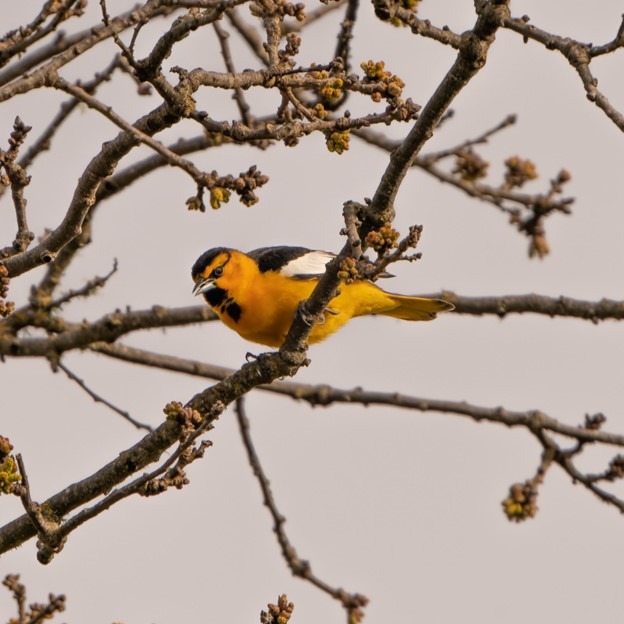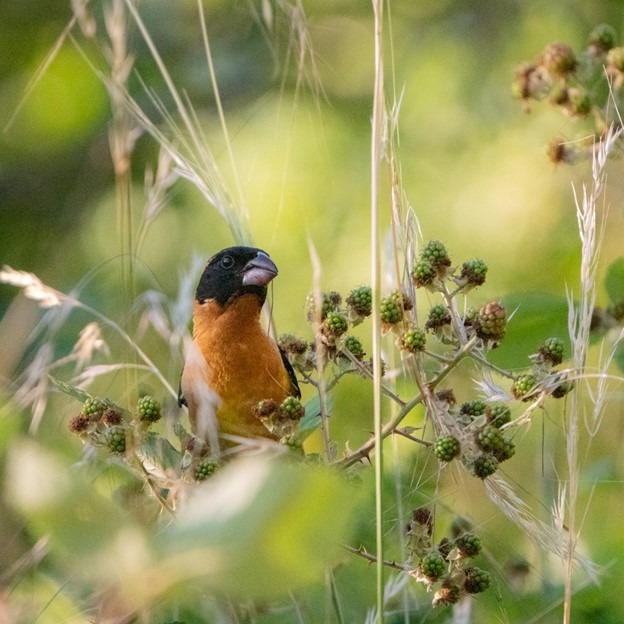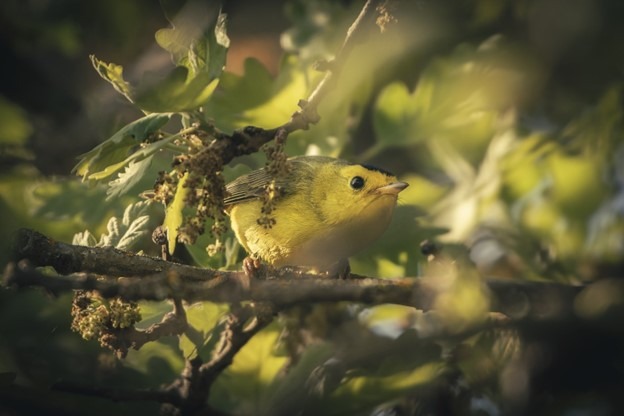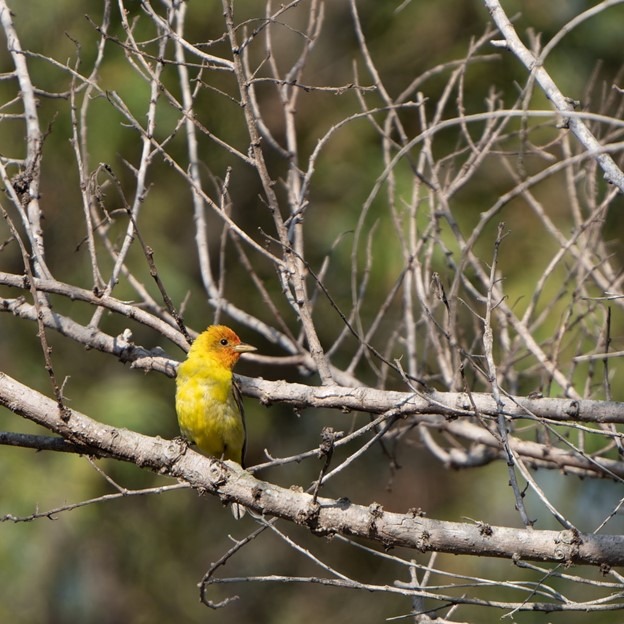
Mountain lions capture our fascination, and we never tire of sharing images and stories of their moment across our preserves – wildlife camera footage, paw prints in the mud, signs of a recent meal, and if we are lucky, the discovery of a den filled with kittens! Our partners at Audubon Canyon Ranch share this fascination and conduct research that reports on the movement and health of our largest wild cat through their Living with Lions program. We know that land conservation ensures the survival of our resident pumas and applies similarly to our avian migrators passing through. Take a walk on the wild side with us as we reveal the diverse species passing through our wilderness. *Be sure to watch NBC’s OpenRoads episode on May 19, which is focused on the mountain lions in Sonoma Valley and includes interviews with Quinton Martins*
The freedom to roam
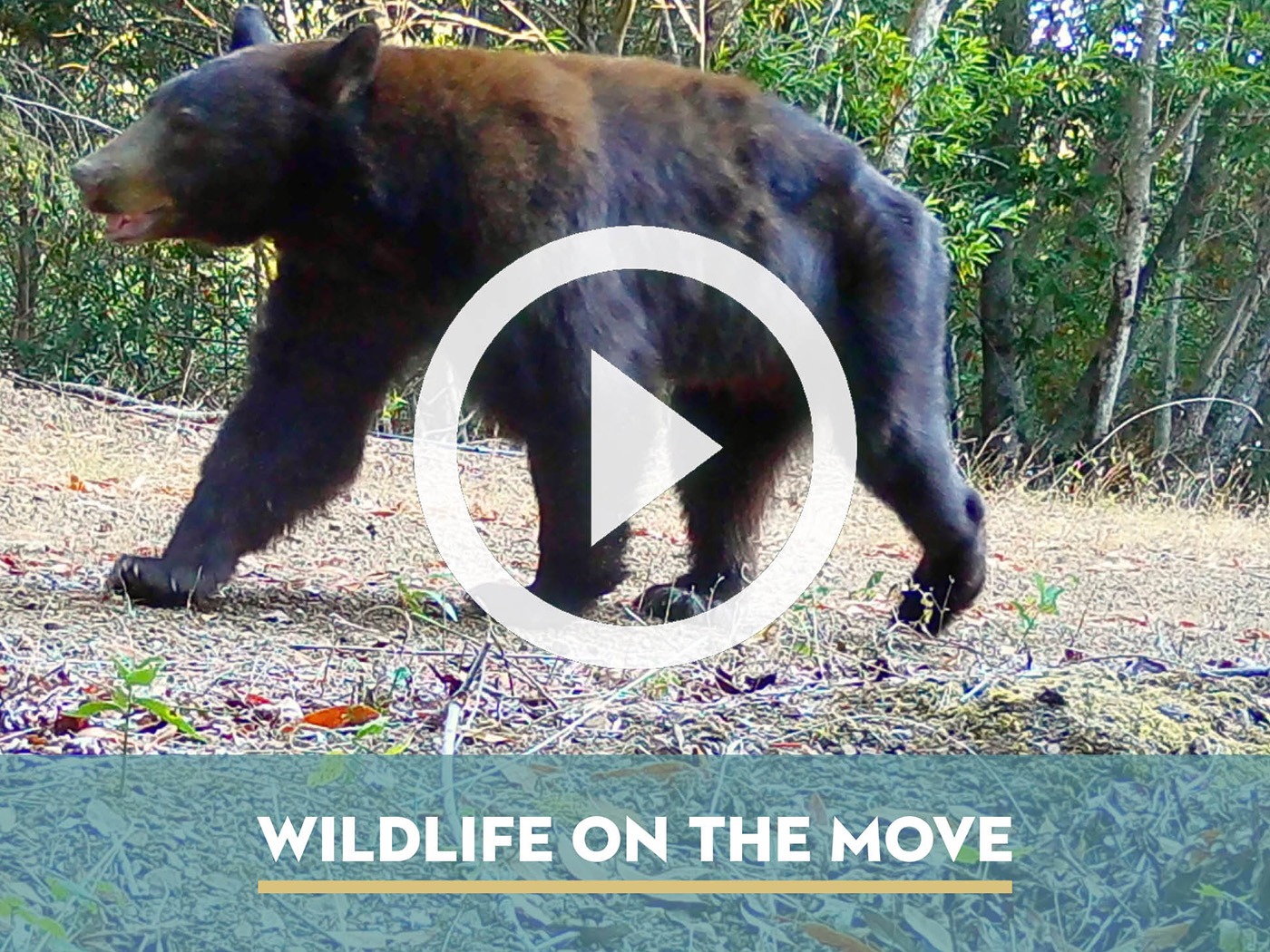
When we look at the 59,000+ acres Sonoma Land Trust has safeguarded across the county over our nearly 50-year history, the projects we pursue contribute to a larger goal beyond adding acreage to that total. With the dual crises of climate change and biodiversity top of mind, we’re acquiring, conserving, and restoring lands with the highest capacity to support connected and healthy habitat and ecosystems. When we preserve large, intact landscapes, wildlife corridors, and natural infrastructure that perform irreplaceable roles in supporting the web of life, we create wildlife refuges for thousands of diverse species that call Sonoma County home. Not only large mammals, like bears and mountain lions, but many smaller animals like raccoons, foxes and bobcats need the ability to move freely and travel long distances safely and (mostly) unseen to feed, shelter, and complete their life cycles. Conservation lands are an oasis for wildlife to thrive, and we’re able to witness the impact of our work through our wildlife cameras. Strategically placed on our preserves throughout the county, these cameras give us a fascinating peek into the secret lives of Sonoma County’s diverse wildlife without disturbing them. Enjoy this front-row seat to nature’s greatest show!
A road not traveled
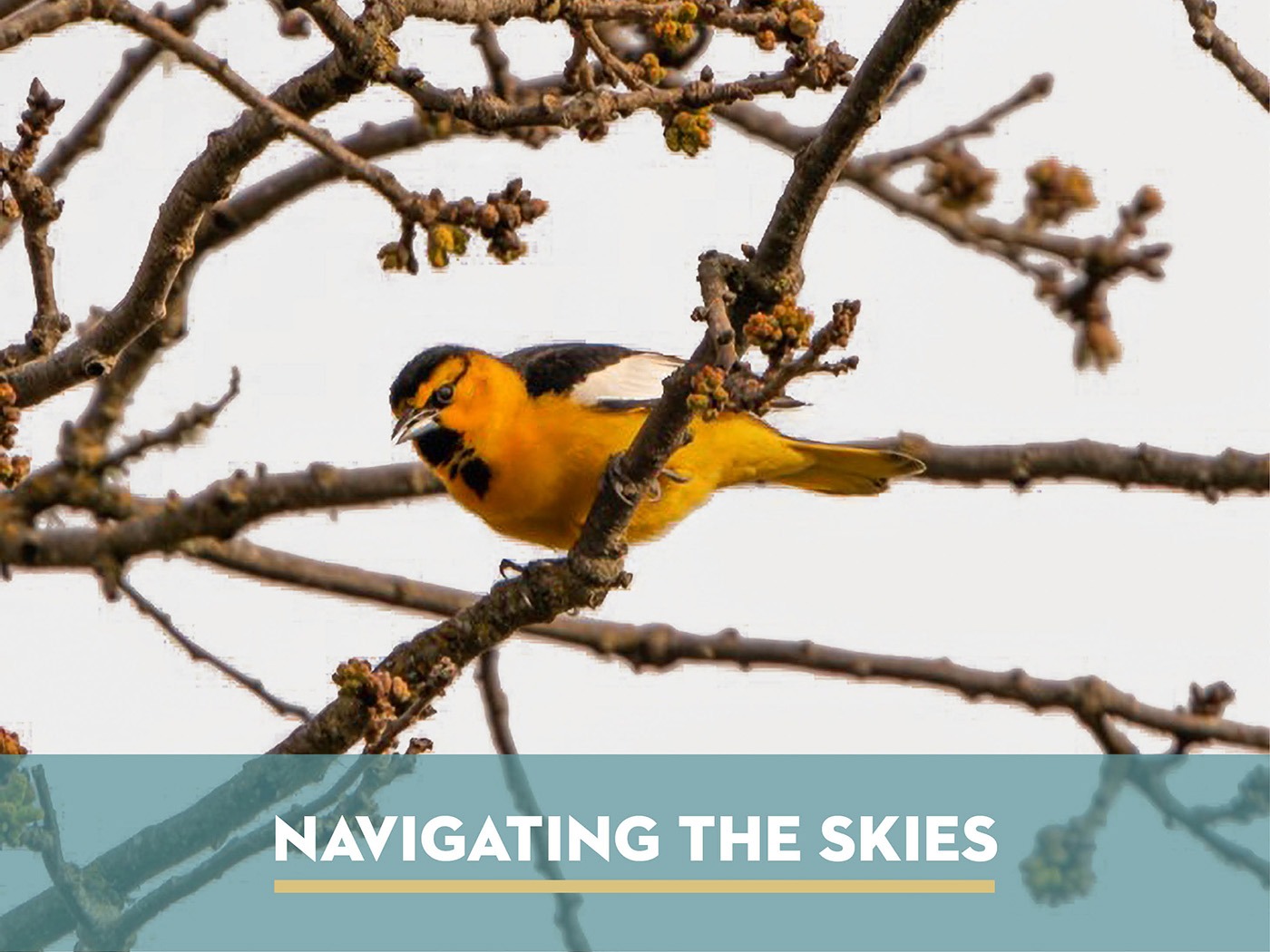
As the days get longer and temperatures rise, migratory animals feel the pull to head north to their breeding grounds. Spring in Sonoma County is a birding paradise offering opportunities to glimpse feathers of all colors and listen to a songs we haven’t heard all year. West Coast migrating avian species stop here to rest and refuel before carrying on their way, and many of them make our wetlands, forests, and even neighborhoods their final destination.
We spoke with our friends at the Sonoma County Feminist Bird Club to learn what they’re most excited to see this time of year, what their migration routes are, and where you might catch a glimpse of them. Read on for their insights about these intrepid adventurers – some travel thousands of miles to take advantage of burgeoning insect populations, budding plants, and nesting locations.
Bullock’s Oriole (Icterus bullockii)
Nothing says spring like the sight of a tangerine-colored oriole hanging upside down from a branch to glean nectar or insects. These summer residents arrive in Sonoma County in late March to breed in open woodland and riparian forests, favoring willows, oaks, and madrones. Orioles build long, pendulous nests that hang from trees, often 30ft above ground. You can spot orioles locally through late August, and some public lands where they’re commonly spotted include the Laguna de Santa Rosa Trail, Helen Putnam Regional Park, and Tolay Lake Regional Park.
Black-headed Grosbeak (Pheucticus melanocephalus)
The Black-headed Grosbeak is stockier than the oriole, with a notably thick bill. These birds migrate to Sonoma County in April to breed and stay through September before heading back to Mexico. You will likely hear the loud and melodious song of this very vocal visitor before you see them – their distinctive call sounds like a sneaker squeaking on a gym floor. Black-headed Grosbeaks are often observed in Riverfront Regional Park, Santa Rosa Creek Trail (especially near the Willowside Rd access point), Hood Mountain Regional Park, and Sonoma Coast State Park.
Wilson’s Warbler (Cardellina pusilla)
The distinctive black cap of the Wilson’s warbler can be seen flitting around willow thickets and near forest edges of Sonoma County beginning in March. These songbirds spend their winters from southern California to Panama and migrate to Coastal California to breed; however, many travel as far north as Alaska. Listen to for their rapid chattering and males singing during migration, or look for their cheerful yellow color (they are often perched at eye level) anywhere around the county, including the Coastal Prairie Trail (near the Bodega Dunes Campground entrance), Tolay Lake Regional Park, Ragle Park, Trione-Annadel State Park, and Shollenberger Park.
Western Tanager (Piranga ludoviciana)
Western Tanagers are known to travel at night on their long voyage from Central America or Mexico. At stopover points during migration, they can be found in city parks, orchards, and suburban areas. Tanagers stay in Sonoma County from about April to October, where they breed in open coniferous forests, especially those with Douglas-fir and ponderosa pine, as well as riparian areas and forest edges. They can be frustrating to find because they like to stay high in the canopy, but keep your eyes open for their flame-colored plumage and listen for their song, which can sound like a shorter, raspier version of the American robin.
*All bird photographs compliments of Jeffer Giang
It’s worth noting that climate change is beginning to have significant impacts on migrating birds and their subsequent reproductive success. With warmer spring weather arriving earlier, critical food sources are available at different times, and birds haven’t adapted their migration timing to keep up with these shifts. Community science websites and apps that compile information gathered by birders of all levels are instrumental to understanding bird migration by developing maps that follow species movement, especially in the context of climate change. Sonoma County Feminist Bird Club recommends:
- eBird – One of the world’s largest biodiversity-related science project, where users around the world contribute their sightings to support data-driven science, conservation, and education.
- Merlin – A bird identification platform and birding coach that uses sound and photos, among other data input by users, to ID species.
- Cornell Lab of Ornithology – The Lab’s website has a wealth of information and resources on species identification and bird migration, as well as background on current population and biodiversity studies.
- All About Birds – A user-friendly online companion for birdwatchers with information on species behavior, life history, and more.
Learn more about Sonoma County Feminist Bird Club on their website, find them on Facebook and Instagram, and join them throughout spring for their weeknight birding series focused on identifying migratory birds. You might just spot one of these species yourself!
Dinner for two or just passing through?
Ongoing tracking data and diet study continue to reveal interesting mountain lion behavior
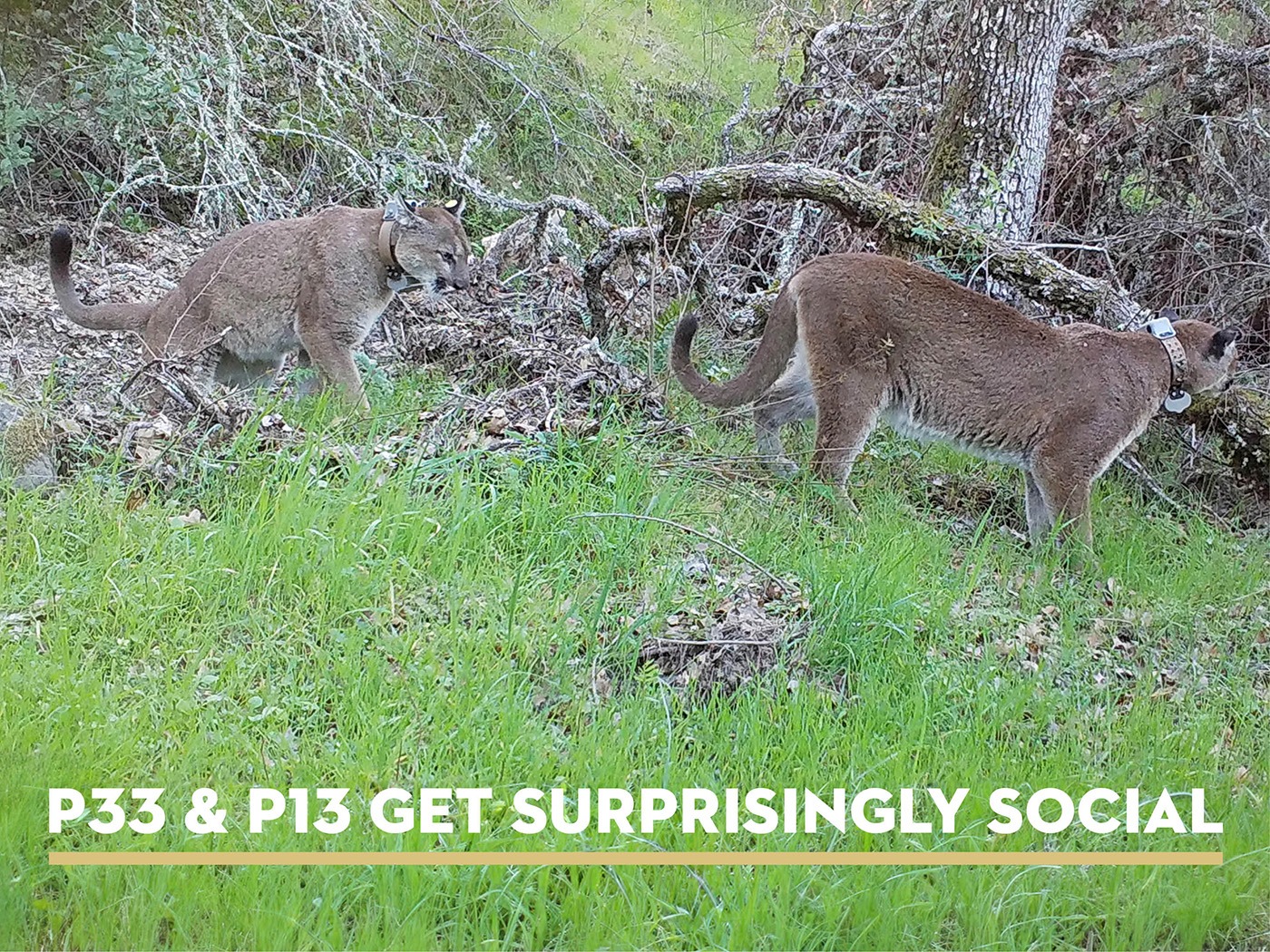
Sonoma Valley mountain lions observed sharing a meal over several days
Authored and shared by Audubon Canyon Ranch
Ongoing tracking data and diet study continue to reveal interesting mountain lion behavior.
It is common to see a pride of African lions sharing a kill, but until recently, it had largely been unheard of for North America’s big cats to gather around a meal. Mountain lions are known to be solitary creatures that are expected to avoid contact with unrelated lions in their range. However, recent research in Wyoming has unveiled behavior that suggests these cats get together more than was previously thought. Based on these findings, Quinton Martins and his research team, who study the movements and behavior of mountain lions in the Napa-Sonoma-Mendocino region, have been on the lookout for similar behavior in the California cats.
So, in July 2022 when Quinton noted GPS-tracking data for the dominant male P13 and female P33 in close proximity to each other, he was eager to better understand what had transpired. Was it a mating event between the two or something else? “From our observations, mating lions typically do not hang about in one place for too long — we would expect to see some movement where the male follows the female for a day or two,” he explained.
In this case, however, the two lions spent most of the time together in a concentrated area (denoted by a cluster of GPS points), behavior more often seen while feeding on cached prey. A quick reconnaissance of the area by graduate student Jake Harvey revealed yet another interesting glimpse into the lives of local mountain lions.

Surprise meal shared between lions
The female mountain lion P33, who was captured and collared for the Living with Lions study in 2021, killed a buck in the Bennett Valley area. To Martins’ surprise, 6-year-old male lion P13 located the kill and spent the following day-and-a-half sharing the meal with P33.
“I have seen this with leopards in Africa before, but never with mountain lions until now,” Martins added.
Sharing of kills has been recorded in the Grand Tetons in Wyoming, but documentation of sharing food by unrelated mountain lions elsewhere has been rare, particularly in regions with a moderate climate, where access to resources remains relatively constant throughout the year – unlike areas like Wyoming or Nevada that get heavy snow in the mountains resulting in more overlap of individual lions in winter. Authors of the work in Wyoming summarized in their discussion: “Direct reciprocity proves a stable cooperative strategy when the costs of sharing are low, there is a high chance of repayment, and animals are likely to interact multiple times…” which alludes to the fact that the mountain lions we are studying are possibly more social than we originally thought.
The two lions spent most of the time by the kill (see cluster map, above), but also a couple of hours together further to the east of the feeding site. “Now 3+ years old, P33 (the female) is quite likely of breeding age, so we will keep a close eye on whether this or future meetings may produce a litter of cubs,” added Martins
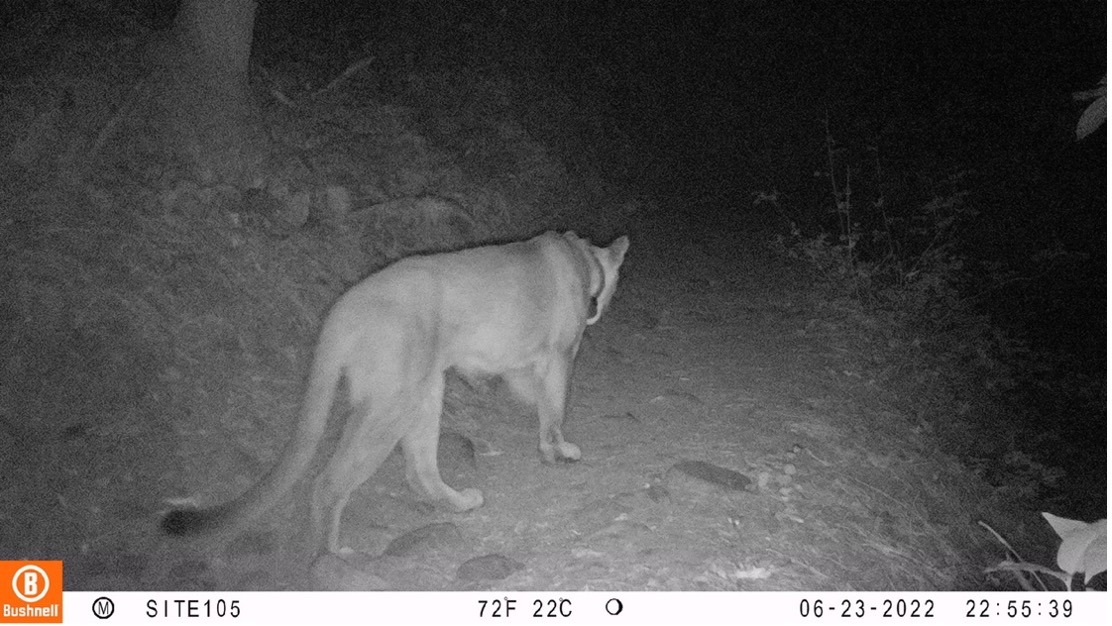
P13 makes a habit of sharing, this time with Super-Puma
Remarkably, not two weeks later, P13 apparently killed a large buck near Trione-Annadel State Park, only to end up sharing the meal with Sonoma’s “Super-Puma” P1, now estimated to be almost 16 years old. In the Wyoming study it was found that males benefitted from female kills more often, as well as older lions exhibiting tolerance more often, making this of added interest to the team to see an old female taking advantage of a males kill. P1 remained at the kill with P13 for 5 days, two times the average length of time spent at deer kills recorded in this North Bay study.
Upon investigation, Jake found the trampled vegetation around the feeding area more disturbed than usual, leaving the team unsure what to make of the interactions between the two lions while at the kill site. Since these first two observations of kill sharing were documented, a second record of P13 and P33 sharing a kill was recently recorded, again with P13 benefiting from a kill made by P33.
| 2022 Monitoring Period Prey Items | 146 |
| Black-tailed deer | 108 |
| Livestock (sheep & goats) | 25 |
| Wild boar | 7 |
| Racoon | 3 |
| Otter | 1 |
| Squirrel | 1 |
| Rabbit | 1 |
| Domestic cat | 1 |
Table 1. Mountain lion diet determined using GPS kill cluster analysis
New, exciting data emerges in continued mountain lion diet study
Although just a slice of an ongoing data collection effort, information gleaned from kill sites in 2022 give researchers even more to chew on about the diet of North Bay mountain lions. Of 188 GPS-cluster sites identified, 131 were visited and 146 prey items found cached or consumed. The most common prey item were black-tailed deer (74%), livestock–goats and sheep (17%), and wild boar (2%).
In western Sonoma County, Jake recorded an otter being killed by male mountain lion P36. “This is the first record of otter in lion diet for our study, which is really exciting,” said Martins.
Since 2016, the Living with Lions research and education project has sought to increase understanding of the mountain lions living in the Northern San Francisco Bay area; to learn what impediments may exist for movement within their range, learn more about their behavior, and help residents reduce risk of conflict with pets and livestock. The project is supported in part by the Disney Conservation Fund, which funds our research as well as our youth education and community outreach programs.
“The sorts of events we have documented during July would simply occur without us knowing anything about them were it not for the use of the GPS collar technology available to us today,” acknowledged Quinton.
For the complete article visit:
https://egret.org/living-with-lions/
Pumas del valle de Sonoma observados compartiendo la comida durante varios días
Los datos de seguimiento y el estudio de la dieta siguen revelando interesantes comportamientos del puma.
Es habitual ver a una manada de leones africanos compartiendo una presa, pero hasta hace poco era prácticamente sin precedentes que los grandes felinos de Norteamérica se reunieran para alimentarse. Se sabe que los pumas, también conocidos como leones de montaña, son animales solitarios que evitan el contacto con otros leones de su área de distribución. Sin embargo, investigaciones recientes en Wyoming revelaron comportamientos que sugieren que estos felinos se reúnen más de lo que se pensaba. A partir de estos hallazgos, Quinton Martins y su equipo de investigación, que estudian los movimientos y el comportamiento de los pumas en la región de Napa-Sonoma-Mendocino, se han puesto a buscar comportamientos similares en los felinos de California.
Así que, en julio, cuando Quinton observó los datos de seguimiento por GPS del macho dominante P13 y la hembra P33 muy cerca el uno del otro, estaba ansioso por comprender mejor lo que había ocurrido. ¿Se trataba de un apareamiento entre ambos o de algo más? Él explicó: “Por lo que hemos observado, los pumas que se aparean no suelen quedarse en el mismo sitio durante mucho tiempo”, explica Quinton.
En este caso, sin embargo, los dos pumas pasaron la mayor parte del tiempo juntos en una zona concentrada (indicada por un grupo de puntos GPS), un comportamiento que se observa más a menudo cuando se alimentan de presas que han escondido. Un rápido reconocimiento de la zona por parte del estudiante Jake Harvey reveló otra interesante visión de la vida de los pumas locales.
Comida sorpresa compartida entre pumas
La puma hembra P33, que fue capturada y marcada con collar en 2021 para el estudio Viviendo con leones (Living with Lions), mató a un ciervo en la zona del valle Bennett. Para sorpresa de Martins, el puma macho P13 de 6 años localizó a la presa y pasó el siguiente día y medio compartiendo la comida con P33.
“Lo había visto antes con leopardos en África, pero hasta ahora nunca con pumas”, añade Martins.
En los Grand Tetons de Wyoming se han registrado casos en los que los pumas no emparentados compartieron la comida, pero en otros lugares ha sido raro documentarlos. Sobre todo en regiones de clima moderado donde el acceso a los recursos permanece relativamente constante durante todo el año. A diferencia de zonas como Wyoming o Nevada donde nieva mucho en las montañas, lo que provoca un mayor solapamiento en invierno de pumas en solitario. Los autores del trabajo en Wyoming resumieron en su discusión: “La reciprocidad directa demuestra ser una estrategia cooperativa estable cuando los costes de compartir son bajos, existe una alta probabilidad de compensación y es probable que los animales interactúen varias veces…”, lo que alude al hecho de que los pumas que estudiamos son posiblemente más sociales de lo que pensábamos en un principio.
Los dos pumas pasaron la mayor parte del tiempo junto a la presa (véase el mapa de grupos, arriba), pero también un par de horas juntos más al este del lugar donde se alimentaron. “Ahora que tiene más de 3 años, es muy probable que P33 (la hembra) esté en edad reproductora, por lo que seguiremos de cerca si esta o futuras reuniones pueden dar lugar a una camada de cachorros”, añade Martins.

P13 acostumbra a compartir, esta vez con Super-Puma
Notablemente, dos semanas más tarde, P13 aparentemente mató a un gran ciervo cerca del Parque Estatal Trione-Annadel para terminar compartiéndolo con la “Super-Puma” P1 de Sonoma, que ahora se estima que tiene casi 16 años de edad. En el estudio de Wyoming se descubrió que los machos se beneficiaban más a menudo de la caza de las hembras y que los mayores mostraban tolerancia con más frecuencia, por lo que el hecho de ver a una hembra de edad avanzada aprovecharse de la caza de un macho resultó de gran interés para el equipo. P1 permaneció con la presa junto con P13 durante 5 días, el doble de la media de tiempo que pasó con la presa de ciervo registrada en este estudio de North Bay.

Tras la investigación, Jake encontró la vegetación pisoteada alrededor de la zona de alimentación más alterada de lo habitual, dejando al equipo sin saber qué hacer con las interacciones entre los dos pumas mientras estaban en el lugar de la presa. Desde que se documentaron estas dos primeras observaciones de presas compartidas, se registró una segunda presa compartida recientemente entre P13 y P33, de nuevo con P13 beneficiándose de una presa cazada por P33.
| Presas del período de seguimiento de 2022 | 146 |
| Ciervo de cola negra | 108 |
| Ganado (ovejas y cabras) | 25 |
| Jabalí | 7 |
| Mapache | 3 |
| Nutria | 1 |
| Ardilla | 1 |
| Conejo | 1 |
| Gato doméstico | 1 |
Tabla 1. Dieta del puma determinada mediante el análisis de agrupación de muertes por GPS
Surgen nuevos y emocionantes datos en un estudio continuado sobre la dieta del puma
Aunque es solo una parte del esfuerzo de recopilación de datos que se está llevando a cabo, la información obtenida en los lugares de muerte en 2022 ofrece a los investigadores aún más información sobre la dieta de los pumas de la Bahía Norte. De los 188 lugares identificados con GPS, se visitaron 131 y se encontraron 146 presas en escondite o consumidas. Las presas más comunes fueron ciervos de cola negra (74 %), ganado ovino y caprino (17 %) y jabalíes (2 %).En el oeste del condado de Sonoma, Jake registró la muerte de una nutria a manos del puma macho P36. “Este es el primer registro en nuestro estudio de nutria en la dieta del puma , lo cual es realmente emocionante”, cuenta Martins.
Desde 2016, el proyecto de investigación y educación Viviendo con leones ha buscado aumentar la comprensión de los pumas que viven en el norte del área de la Bahía de San Francisco, aprender qué impedimentos pueden existir para el movimiento dentro de su territorio, aprender más sobre su comportamiento y ayudar a los residentes a reducir el riesgo de conflicto con sus mascotas y ganado. El proyecto cuenta en parte con el apoyo del Fondo de Conservación Disney (Disney Conservation Fund), que financia nuestra investigación, así como nuestros programas de educación juvenil y divulgación comunitaria.
“El tipo de sucesos que documentamos durante el mes de julio ocurrirían sin que supiéramos nada al respecto si no fuera por el uso de la tecnología de collares GPS de la que disponemos hoy en día”, reconoce Quinton.
Referencia al inglés: https://egret.org/sonoma-valley-mountain-lions-observed-sharing-a-meal-over-several-days/
A Force for Nature Spotlight: A conversation with supporter Maria Cardamone

When Maria was a teenager in Washington D.C., she spent her weekends backpacking in the Appalachians, and she vowed that one day she would live in the wilderness. “It took a while to realize that dream,” she says from the porch of her house between Bodega Bay and Jenner. Maria and her husband, Paul Matthews, live several miles inland, on 250 acres surrounded by state park lands adjacent to the Willow Creek watershed area.
It was here one evening in 2019 that Maria penned her goats in the barn for the night and left her two llamas out to graze like so many other nights before. When she saw their dead bodies the next day, Maria called Quinton Martins, asking if it was a big game kill.
A native of South Africa, Quinton grew up with large animals and has studied them his whole life. Now in Sonoma Valley, his company True Wild partners with Audubon Canyon Ranch, tracking the behavior and health of mountain lions through the Living with Lions program.
“After getting my call, he came out to the coast from the eastern part of the county to observe. He told us to dig up Rocky, one of the llamas we had just buried. It was one of the few times I ever heard my husband swear.” Quinton used the llama to create a live trap and left the property. At 3am the following morning he called with news from the webcam: “We’ve got a kitty,” he told her.
Quinton knew that mountain lions are loners. They feed primarily on deer and unsecured livestock and usually come back to the site to eat the rest of their prey. Maria watched as the research team returned to the property and sedated the cat whom they named P14 “Paul” in honor of her husband (although it actually stands for Puma). They took DNA samples, checked his teeth, and fitted him with a collar so they could track his behavior. Through P14, Quinton was now about to extend his research and education into the coastal area of the county.
“I just couldn’t kill the lion,” said Maria. “It was on me that the llamas died. I should have enclosed them.” In Maria’s mind, another life should not be sacrificed because of her lapse in judgment.
“The mountain lions live here too. Even though they are large and frightening and at the top of the food chain, they are also fragile and vulnerable. They die easily, from being shot or poisoned from eating chemicals sprayed on the plants. It is the owner’s responsibility to enclose and protect their livestock from predators. The mountain lions are merely getting food to survive.”
Deer are one of their main food sources, and the lions’ survival helps keep the deer population in check. Mountain lions’ lives are tough and they’re shy. They avoid humans.
“I got to touch him while he was sedated,” Maria tells me. “His fur was thick and stiff. His tail was the size of my arm and felt like one long piece of muscle. Very formidable. He lived for a few years before he was tragically shot by a rancher near Sea Ranch. It isn’t right.” Maria and Paul have made their property more wildlife-friendly by removing old fences.
Like the Sonoma Land Trust, Maria, and Paul partner with local organizations to further their ecological goals. “We work with the Russian River SHaRP program (Salmon Habitat Restoration Priorities) to repopulate salmon in the creek and with Sonoma County Regional Parks to provide access for hiking and camping.” As part of their plan to educate people and remediate the land, they have invited groups of women to do vision quests in the summer, making the land a safe and accessible environment. They’ve also brought other diverse groups out to experience the wilderness.
Maria and Paul’s connections with people, agencies, and the flora and fauna around them mirror the mission of Sonoma Land Trust, an intent to “protect the open, natural, and working lands and waters of Sonoma County to secure healthy and thriving futures for all.”
“We love the work of Sonoma Land Trust, especially their Greenway Project in Southeast Santa Rosa,” says Maria. “And we love it here, even though the 4-mile dirt road can be a real pain, especially when it floods. People protect what they love! We love the land. Allow people to have access to these areas, don’t beat them up with laws. Once they are out in nature, they will also work to protect it.”
Maria’s perspective shows a vast connectivity to our earth and all beings who live on it. It grows our connection to each other. It benefits us all.
Interview and article compliments of Sharon Bard
Welcoming new staff

Erin brings over 15 years of environmental fundraising experience to her role on the philanthropy team. A native Texan, Erin was drawn to California in 2019 and is thrilled to be working to protect the incredible landscapes that inspired her to the West Coast. She has global experience in major and principal gifts, foundations, and capital campaigns for The Nature Conservancy and Natural Resources Defense Council, and holds a BA in Anthropology and Spanish from Vanderbilt University. Erin resides in Windsor with her partner and his two children. Outside of work, she enjoys cycling, wine tasting, and savoring all the bounty of our beautiful region.

Camille joins Sonoma Land Trust with the goal of building collaborative and long-lasting relationships that help conserve the beauty and biodiversity of Sonoma County and ensure a climate-resilient future for generations to come. In her previous position with Global Fund for Women, she gained 12 years of experience fundraising and advocating for transformative change at the intersection of women’s rights and gender, economic, and environmental justice. Outside of work, you’ll find Camille gardening, foraging for mushrooms, and visiting Sonoma County skateparks with her husband and two young children.
Events
PRIDE

June 1
Join us for the annual Sonoma County Pride parade and celebration! Stop by our booth in Old Courthouse Square to win prizes, meet our drag animals, and learn about queerness in nature – see you there!
Child in the Wild

June 2, 12pm to 4pm
Join us for this free, family-friendly event at Howarth Park in Santa Rosa. Enjoy nature activities, food trucks, and performances by the Sonoma County Pomo Dancers, Danza Xantotl, Redwood Empire Chinese Association Dragon Dancers, and Jeffrey Whitebear & The Wild Ones.
Free webinars

Language of the Land: The Voice of the Natural World: Wednesday, May 29, 7pm
Join Sonoma Land Trust for a presentation by soundscape ecologist Bernie Krause for a dive into the world of biophonies — the collective sound produced by all organisms in a given habitat. This program will trace the history and power of natural soundscapes, exploring how they have changed and what they tell us about the future.

Learn more about private conservation efforts in Chile to protect its rare Mediterranean habitats with the Fundación Tierra Austral, exploring their achievements and challenges.
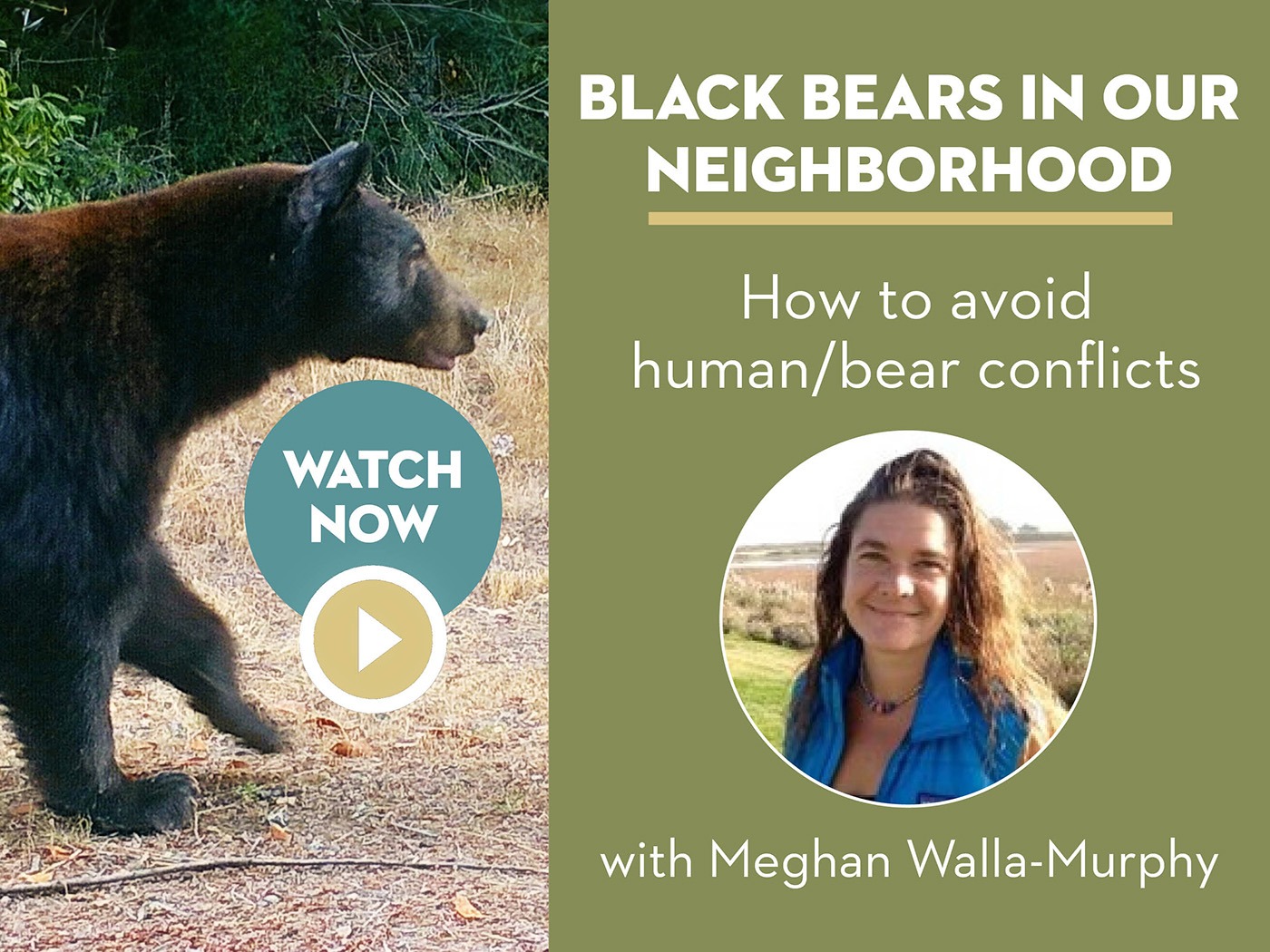
Meghan Walla-Murphy, wildlife ecologist, educator, and lead coordinator for the North Bay Bear Collaborative teaches us more about the behavior and range of black bears, as well as what we can do to improve human/bear interactions.
Join us in nature
Join us out in nature this month! We’ll enjoy magnificent wildflower blooms throughout the county, explore the Sonoma Mountain Vernal Pools property, and more. Visit our outings page to register.
Many of these hikes are in partnership with Sonoma County Ag + Open Space.
Recommendations

Crossings by Ben Goldfarb offers a captivating exploration of the intricate relationship between wildlife migration and human civilization, intertwining science, history, and personal narratives to illuminate the critical importance of safeguarding migration corridors in our increasingly fragmented world.

